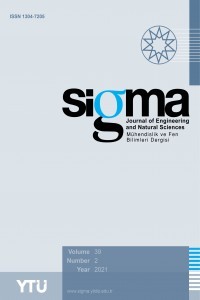IMPROVING EROSION PROPERTIES OF STEAM TURBINE BLADES VIA SURFACE MODIFICATIONS
IMPROVING EROSION PROPERTIES OF STEAM TURBINE BLADES VIA SURFACE MODIFICATIONS
Steam turbine blades, martensitic steels, HVOF laser hardening, erosion.,
___
- [1] V. A. B.S. Mann, “An experimental study to corelate water jet impingement erosion resistance and properties of metallic materials and coatings,” Wear, cilt 253, pp. 650-661, 2002.
- [2] V. A. B. S. Mann, “HVOF coating and surface treatment for enhancing droplet erosion resistance of steam turbine blades,” Wear, cilt 254, pp. 652-667, 2003.
- [3] J. S. Ivo Cerný, “Fatigue strength of laser hardened 42CrMo4 steel considering effects of compressive residual stresses on short crack growth,” Procedia Engineering, cilt 74, pp. 417-420, 2014.
- [4] N. Frees, “Cavitation erosion of titanium carbide coatings on cemented carbides and other substrates,” Wear, cilt 88, no. 1, pp. 57-66, 1983.
- [5] B. C. L. R. N. S. a. S. K. Syamala Rao, “Cavitation Erosion Studies With Venturi and Rotating Disk in Water,” ASME Journal of Basic Engineering, cilt 92, pp. 563-573, 1970.
- [6] M. T., A. S. R. A., J. S. B. Mahmoudi, “Laser surface hardening of AISI 420 stainless steel treated by pulsed Nd:YAG laser,” Materials and Design, cilt 31, p. 2553–2560, 2010.
- [7] F. C., H. M., K. H. Lo, “Laser transformation hardening of AISI 440C martensitic stainless steel for higher cavitation erosion resistance,” Surface and Coatings Technology, cilt 173, p. 96–104, 2003.
- [8] J. V. P. G. J. B. J. G. J. T. I. Fagoaga, “Multilayer coatings by continuous detonation system spray technique,” Thin Solid Films, cilt 317 , p. 259–265, 1998.
- [9] J. B. J. G. A. B. P. S. N. Espallargas, “Cr3C2–NiCr and WC–Ni thermal spray coatings as alternatives to hard chromium for erosion–corrosion resistance,” Surface & Coatings Technology, cilt 202, pp. 1405-1417, 2008.
- [10] B. J. M. H. S. Matthews, “High temperature erosion–oxidation of Cr3C2–NiCr thermal spray coatings under simulated turbine conditions,” Corrosion Science, cilt 70, pp. 203-211, 2013.
- [11] G. M. L. Murari P. Singh, “Turbine Blade Construction, Materials and Manufacture,” %1 içinde Blade Design and Analysis for Steam Turbines, Mc Graw Hill, 2011, pp. 67-78.
- [12] J. P. I. W. T. G. Prieto, “Cryogenic treatments on AISI 420 stainless steel: Microstructure and mechanical properties,” Materials Science & Engineering A, cilt 605, pp. 236-243, 2014.
- ISSN: 1304-7191
- Başlangıç: 1983
- Yayıncı: Yıldız Teknik Üniversitesi
Harun AKKUŞ, Harun YAKA, Levent UĞUR
FIGHTER MOLECULES AGAINIST TO CANCER – PEPTIDE VACCINES
Buket ERGİN, Pelin PELİT ARAYICI, Zeynep MUSTAFAEVA, Baxtiyar MAMEDOV
PRACTICAL METHODS FOR THE ESTIMATION OF HYDROELECTRIC POWER POTENTIAL OF POORLY GAUGED BASINS
Necati AGIRALIOGLU, Ebru ERIS, Gokhan ANDIC, H. Kerem CIGIZOGLU, H. Gonca COSKUN, Levent YILMAZ, Ugur ALGANCI, Z. Fuat TOPRAK
Selami DEMİR, Aykut KARADENİZ, Hülya CİVELEK YÖRÜKLÜ, Neslihan MANAV DEMİR
AN INVESTIGATION OF GRINDING CHARACTERISTICS OF NA-FELDSPAR BY MEANS OF THE KINETIC MODEL PARAMETERS
Serhan HANER, Bülent HANER, Tarık TUNAY
RITZ SOLUTION OF BUCKLING AND VIBRATION PROBLEM OF NANOPLATES EMBEDDED IN AN ELASTIC MEDIUM
IMPROVING EROSION PROPERTIES OF STEAM TURBINE BLADES VIA SURFACE MODIFICATIONS
Ağça BAĞCAN KAYIHAN, Cengiz KAYA
DETERMINING SURFACE TOPOGRAPHY FOR CYLINDER LINER SURFACES USING 2D FAST FOURIER TRANSFORM
İsmail BÖĞREKCİ, Pınar DEMİRCİOĞLU, Hilmi Saygın SUCUOĞLU, Ahmet Fatih HACIYUSUFOĞLU
INFRARED DRYING CHARACTERISTICS OF JERUSALEM ARTICHOKE SLICES
Okey-onyesolu Chinenye FAİTH, Ude Callistus NONSO, Onukwuli Okechukwu DOMİNİC, Okoye Chukwunonso CHUKWUZULOKE
